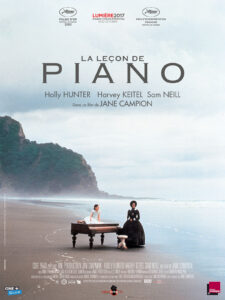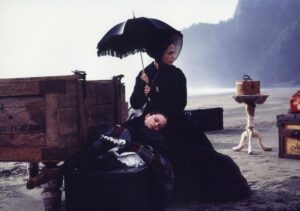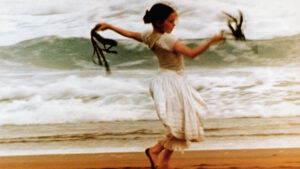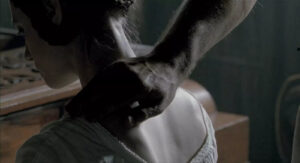“The Piano” – Silent Play of the Senses [Review]

Title: “The Piano”
Release Date: 1993
Director: Jane Campion
Cast: Holly Hunter, Harvey Keitel, Sam Neil, Anna Paquin
There are few films as moving as Jane Campion’s Oscar-winning masterpiece, “The Piano”. It’s a highly lyrical story about a woman who gains the courage to decide for herself in a hostile world. It’s also a film about building one’s own space despite the limitations imposed by social convention. In Campion’s work, freedom is only conceivable outside the verbal realm, so the characters reject words in favor of body language and music.
“The Piano” from 1993 is undoubtedly an outstanding work, which delights as a wonderful combination of an interesting plot, visual artistry, great acting performances and, of course, Michael Nyman’s unforgettable music. The picture is set in the 19th century on the territory of New Zealand. The main character is Ada McGrath (played by Holly Hunter), who is married off by her father by correspondence to a man living in a British colony on a desolate island. So the woman, along with her daughter Flora (Anna Paquin), arrives by sea to the new world, bringing with her a huge piano.
The instrument is especially close to the heart of Ada, who has been speechless since the age of six and communicates with the world through music, among other means. It turns out, however, that her newly married spouse Alisdair (Sam Neil) does not agree to transport the piano to a high rise home. And soon, against his wife’s wishes, he sells the instrument to a certain Bains (Harvey Keitel) in exchange for a large tract of land. The new piano owner persuades Alisdair to have his wife give him playing lessons. In reality, however, the man is fascinated by Ada and wants to spend as much time with her as possible. He offers the woman a deal: in exchange for “lessons” during which Bains tries to get closer to the teacher, the heroine will be able to get her beloved instrument back. After some time, the increasingly infatuated man gives the piano back to Ada. Nevertheless, the woman can not forget about Bains and starts an affair with him. Angered by this, Ada’s husband cuts off the woman’s finger in a fit of rage. Eventually, however, Alisdair, unable to bear that his wife loves another, allows the lovers, along with little Flora, to leave the island.

Woman as the Other in the film “The Piano”
“The Piano” is a work in which, as in all Jane Campion’s films, the central place is occupied by a woman. It is from her point of view that we observe events – the compositional framework for the work is the statement of the heroine herself, who speaks to the viewer with “her inner voice.” Furthermore, she is a woman clashing with an oppressive patriarchy, trying to find her own place in a hostile culture. Ada arrives from the outside into a hermetic world, which heightens the impression of her alienation. The woman is an Other also because of her impotence, emphasizing her isolation from the community, and because of her different sensibilities from others.
Ada’s uncharacteristic behavior almost immediately arouses concern in her husband and his family. When the heroine, longing for her instrument, “plays” on the kitchen table, everyone attributes mental illness to her. The role assigned to the woman by social convention is truly deplorable. From the beginning, she is treated as her husband’s personal property, which is supposed to fulfill the function of enriching his life. Symbolically underscored by this fact is the scene when Alisdair looks at a small effigy of his wife, which turns out to be nothing more than the frame of the mirror in which she constantly looks at herself. The man’s relatives initially take the heroine’s silence for good coin. After all, as Ada’s sister-in-law says, it’s easiest to like the “silent animal”.
“The Piano” – between oppression and protection of convention
“The Piano” shows the role of social convention in an extremely interesting way. The British, who inhabit the island, are strangers there and prove to be extremely hermetic in their clash with the local community. The colonizers even cling to their customs, even though they seem useless and even ridiculous in the New Zealand bush. Alisdair drinks his afternoon tea with milk with anointment, which he stirs clockwise with a spoon, wears an elegant outfit with a cylinder and constantly combs through his hair with a handy comb.

Attachment to convention provides a sense of identity, of course, but at the same time makes it completely impossible to know what is different. Alisdair, deaf to any dissent from what is sanctioned by familiar custom, is unable to establish an understanding with his wife. Ada’s silence reduces her in her husband’s eyes to the level of a mute animal, devoid of an inner life that only needs to be tamed a little.
In the case of women, their attire in the film “The Piano” particularly highlights the oppressive role of culture. Long dresses on wooden wheels prove to be an extremely useless closet in the tropical bush. Women are constantly drowning in mud, and their clothes are, as it were, an instrument of enslavement. On the other hand, convention clearly serves a protective function. It is highlighted, for example, in the scene in which Ada, who has arrived on the island, spends the night on the windy beach with her daughter. She then uses her circle petticoat as a protective tent for herself and the child. And in another situation, an uncomfortable dress prevents Alisdair from raping his wife.
The film “The Piano” – the ambivalent role of nature
Nature, like culture, also has an ambivalent face in “The Piano”. On the one hand, there is a hostile, suffocating bush, and on the other, a magnificent seascape. Nature reflects the emotional states of the heroine. The bush, full of mud and wild vegetation, emphasizes Ada’s imprisonment in an unwanted marriage. In contrast, the open expanse of the beach and the sea are symbols of the freedom, beauty and joy the woman experiences when she plays the piano.

The scene in which Baines takes Ada and Flora to the sea to enjoy the sound of the piano is one of the key and most beautiful in the film. It is then that we first hear Michael Nyman’s magnificent part, which is the main musical theme of the work. Also worth noting is the final image of the piano at the bottom of the ocean with Ada’s figure suspended above it. The complete silence and cold colors evoke associations with death, but also with the achievement of inner peace and the final resolution of conflicts.
Jane Campion’s “The Piano” – silence and alternative languages
“The Piano”, nonetheless, is first and foremost a film about silence and building understanding beyond the space of words. Silence has multiple meanings here. Ada’s impotence symbolically refers to the social status of women deprived of their own voice. The particularly dramatic consequences of this mutilation are evident when Alisdair attempts to rape Ada or when he cuts off her finger – and she cannot scream. Interestingly, this scene is a narrative reenactment of the local community’s staged play about Bluebeard murdering his successive wives.
On the other hand, it seems that silence has somehow been chosen by the heroine. As such, it can even be interpreted as a rebellion against language – the main tool for constructing the narrative of patriarchy. Feminist theories emphasize that the very structure of language reflects the subordinate position of women in society. Indeed, in European languages, it is the masculine gender that is normative, causing the term “man” to mean as much as “man,” while “woman” is always an indefinition, so femininity marks a deviation from the norm in the realm of language and culture.

Language is also a basic tool for building a culture, reflecting the prevailing conventions. Alienation towards it is demonstrated not only by Ada, but also by George Bains, as an illiterate man. Bains, like Ada, is a misfit. His rejection of cultural familiarity is emphasized by the exotic tattoos on his face. It’s no wonder, then, that a deep relationship is established precisely between these two Others who are rebelling against the Logos culture.
Ada and Bains’ alternative language in “The Piano” turns out to be sound and touch. George becomes interested in Ada when he first sees her playing the piano. In turn, a thread of understanding is established between the characters when the man touches his teacher. Touch and sound are linked here – for Ada has a sensual relationship with her instrument – she makes sound by lovingly touching the individual keys. Analogously, Bains does the same with Ada, one can say that she becomes a metaphorical instrument in his hands, for touch removes alienation and gradually builds an extremely deep sensual relationship. The nature of this understanding is reflected in the scene in which the man takes off his clothes and passionately wipes the dusty piano with them.
“The Piano” movie (1993) – the ambiguity of the title instrument
The piano itself is an ambiguous prop. The instrument can be a sign of the heroine’s rich inner life, her desires and ambitions. In this sense, Ada’s deprivation of the piano by her husband suggests his negative attitude toward femininity. Alisdair reduces his wife only to biological functions, treating her intellect and dreams as unnecessary ballast. Contrasting this behavior is the behavior of Bains, who sees Ada as an equal partner and decides to take the piano on the boat, even risking sinking it. The woman’s sensual relationship with the instrument is also underscored by the moment when Ada takes out one of the keys to send it to Bains as a loving confession. For the illiterate George, this gesture may be the most telling – for it signifies that just as the instrument without the keys becomes mute, so Ada’s life without her beloved loses its meaning.

The piano in Ada and George’s return journey, on the other hand, is compared to a coffin. This is because it is a reservoir of the past, painful memories and suffering. This is why Ada wants to get rid of it and orders the instrument to be thrown into the ocean. For a moment the heroine wants to commit suicide and go to the bottom together with the piano. At the last moment, however, she chooses life. The image of the dead Ada floating at the bottom of the ocean may symbolize the final severance from the past and the abandonment of social alienation in favor of redefining her place in society.
Although this is, as she states, the role of a local “peculiarity,” it suits the heroine. Love becomes a path of liberation. It restores Ada’s sense of dignity by making an independent choice and enables her to come to terms with the world. In her new home, Ada takes music lessons and, significantly, learns to speak. The beautiful costumes of the characters with distinctive colors in the final scenes of “The Piano” movie emphasize the transformation and happiness of the lovers, achieved in spite of social patterns, but in accordance with their own desires.
Literature:
M. Radkiewicz, “W poszukiwaniu sposobu ekspresji. O filmach Jane Campion i Sally Potter”, Kraków 2001.
